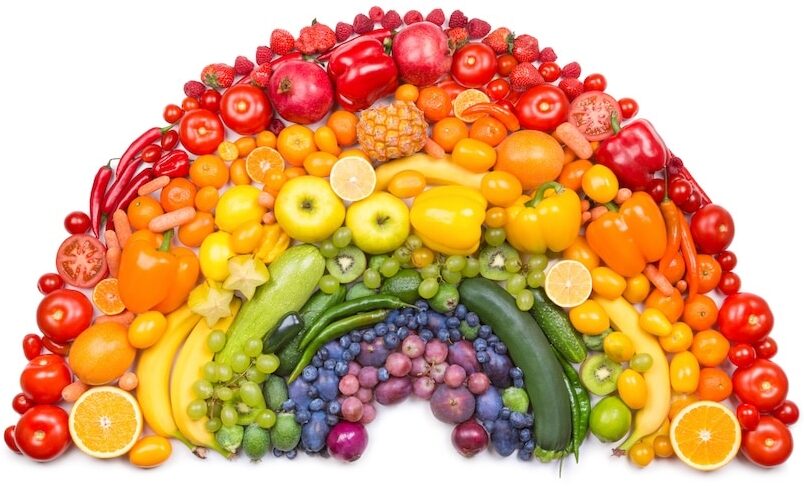
by Lisa Shettle, MS, RDN, CD-N
March is National Nutrition Month, a time to focus on prioritizing your nutrition. One thing that’s usually lacking in people’s diets is adequate fruit & vegetable intake. A challenge to improve your nutrition this month might be aiming to “eat the rainbow”. Eating a variety of colorful foods will nourish you with a wide array of phytonutrients to keep you feeling your best.
Fruits and vegetables provide lots of nutrients without many calories and are full of fiber (good for your gut). Different colors mean different nutrients; for example, blueberries have different vitamins, minerals, and phytochemicals, compared to oranges.
How to eat the rainbow of colorful foods
Here are some suggestions to help you diversify your fruit and vegetable intake with a list sorted by color, along with the phytonutrients they contain, and which foods you’ll find them in.
Red: Rich in the carotenoid lycopene; anti-cancer; anti-inflammatory; cell protection; seems to protect against prostate cancer and heart disease.
Found in: Strawberries, cranberries, raspberries, tomatoes, cherries, apples, beets, watermelon, red grapes, red peppers, red onions
Orange and yellow: Provide beta cryptoxanthin; high in vitamin c; immune support , cell protection; anti-cancer; anti-bacterial; may reduce the risk of heart disease.
Found in: Carrots, sweet potatoes, yellow peppers, oranges, bananas, pineapple, tangerines, mango, pumpkin, apricots, winter squash (butternut, acorn), peaches, cantaloupe, corn
Green: rich in cancer-blocking chemicals like sulforaphane, isothiocyanates, and indoles, which inhibit the action of carcinogens; anti-inflammatory; associated with improved mood and cognition.
Found in: Spinach, avocados, asparagus, artichokes, broccoli, alfalfa sprouts, kale, cabbage, Brussels sprouts, kiwi fruit, collard greens, green tea, green herbs (mint, rosemary, sage, thyme, and basil)
Blue and purple: contain the antioxidants anthocyanins; heart-healthy; anti-cancer; anti-inflammatory; cell protection.
Found in: Blueberries, blackberries, elderberries, Concord grapes, raisins, eggplant, plums, figs, prunes, lavender, purple cabbage
White and brown: The onion family contains allicin, which has anti-tumor properties; anti-cancer; anti-microbial; cell protection; promotes gastrointestinal health. Other foods in this group contain antioxidant flavonoids like quercetin and kaempferol.
Found in: Onions, cauliflower, garlic, leeks, parsnips, daikon radish, mushrooms
Eating the rainbow may be easier than you think! Try to add different colored fruits or vegetable to your meals and have them as snacks. If you have access to fresh produce, try to eat what’s in season for food most rich in phytonutrients. Click here to find a local farmers market in Connecticut.
Get started with these 2 colorful spring recipes
Spring Vegetable Pasta Salad
Greek Kale & Edamame Salad
CELEBRATE NATIONAL NUTRITION MONTH BY PRIORITIZING YOUR NUTRITION
TAKE ADVANTAGE OF YOUR PREVENTATIVE HEALTH INSURANCE BENEFITS & MAKE AN APPOINTMENT WITH ME
A registered dietitian provides medical nutrition therapy and is your best source of reliable and evidence-based nutrition information. An RDN can also help you determine measurable and achievable goals within your individualized plan for your best health outcomes.
BONUS: Services are covered by most health insurance plans!
Source: Institute of Functional Medicine



